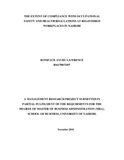| dc.contributor.author | Ayubu, Boniface,L | |
| dc.date.accessioned | 2016-05-18T16:13:44Z | |
| dc.date.available | 2016-05-18T16:13:44Z | |
| dc.date.issued | 2010 | |
| dc.identifier.uri | http://hdl.handle.net/11295/95776 | |
| dc.description.abstract | The objective of the study was to determine the extent to which employers have
implemented Occupational Safety and Health regulations at their workplaces. It further
determined the measures organizations have put in place at their workplaces to comply
with the occupational safety and health regulations. The study was based on a population
of 2168 registered workplaces in Nairobi, of which a sample of 112 was taken. The
sample size was determined according to Bartlett et al (2001), table for determining
sample size for a given population. The study was a survey design and primary data was
collected using questionnaires. The data was analyzed using descriptive, factor and
regression analysis. The elements used to determine the extent of compliance with
occupational safety and health regulations at workplaces were categorized into five
factors (independent variables) namely; safety, hygiene, emergency fire protection and
health regulations. All the independent variables were linearly related with the dependent
variable using a model of five predictor variables to rate the compliance with
occupational safety and health regulations at workplace.
The study found that 90 percent of the respondents were generally aware of the existence
of the Occupational Safety and Health Act, 2007. Over 80 percent of the respondents
were of the view that administration and enforcement of the Occupational Safety and
Health Act, 2007, was good and the Act gives adequate provisions for the safety and
health of employees at workplace. However, inspection and examination of workplaces
by occupational safety and health officers is at the level of 52.2 percent, which is low and
could be perhaps one of the factors responsible for lack of full compliance. Overall, the
v
extent of compliance with Occupational Safety and Health regulations at workplaces
stands at 64.49 percent. Organizations still have an outstanding 35.51 percent level of
no-compliance which they need to work on in order to minimize the consequences of
non-compliance. | en_US |
| dc.language.iso | en | en_US |
| dc.publisher | University of Nairobi | en_US |
| dc.rights | Attribution-NonCommercial-NoDerivs 3.0 United States | * |
| dc.rights.uri | http://creativecommons.org/licenses/by-nc-nd/3.0/us/ | * |
| dc.subject | health regulations | en_US |
| dc.title | The extent of compliance with occupational safety and health regulations at registered workplaces in Nairobi | en_US |
| dc.type | Thesis | en_US |
| dc.description.department | a
Department of Psychiatry, University of Nairobi, ; bDepartment of Mental Health, School of Medicine,
Moi University, Eldoret, Kenya | |



